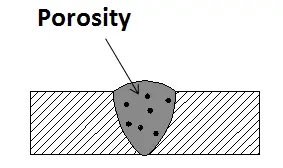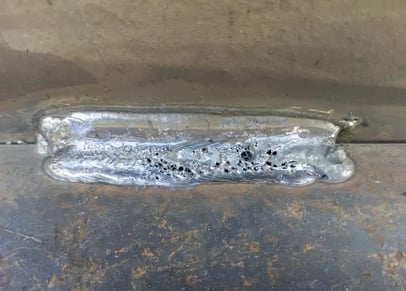Comprehensive Guide: What is Porosity in Welding and How to stop It
Wiki Article
The Science Behind Porosity: A Comprehensive Overview for Welders and Fabricators
Comprehending the intricate devices behind porosity in welding is crucial for welders and makers pursuing flawless craftsmanship. As metalworkers explore the midsts of this phenomenon, they discover a globe regulated by numerous elements that affect the formation of these tiny voids within welds. From the make-up of the base materials to the intricacies of the welding process itself, a multitude of variables conspire to either exacerbate or minimize the visibility of porosity. In this detailed overview, we will certainly unwind the scientific research behind porosity, discovering its results on weld quality and unveiling advanced strategies for its control. Join us on this trip through the microcosm of welding flaws, where accuracy meets understanding in the quest of remarkable welds.Understanding Porosity in Welding
FIRST SENTENCE:
Examination of porosity in welding exposes essential insights right into the integrity and quality of the weld joint. Porosity, identified by the visibility of tooth cavities or voids within the weld steel, is a typical concern in welding procedures. These gaps, otherwise properly dealt with, can jeopardize the structural honesty and mechanical homes of the weld, resulting in potential failures in the ended up item.
To detect and evaluate porosity, non-destructive screening techniques such as ultrasonic testing or X-ray inspection are usually used. These methods enable the recognition of interior problems without compromising the honesty of the weld. By evaluating the size, form, and circulation of porosity within a weld, welders can make educated decisions to boost their welding procedures and achieve sounder weld joints.

Variables Affecting Porosity Formation
The occurrence of porosity in welding is influenced by a myriad of factors, varying from gas securing efficiency to the complexities of welding criterion setups. One important factor adding to porosity development is insufficient gas protecting. When the shielding gas, commonly argon or carbon dioxide, is not properly covering the weld pool, atmospheric gases like oxygen and nitrogen can infect the molten steel, causing porosity. Additionally, the sanitation of the base materials plays a substantial function. Contaminants such as rust, oil, or wetness can vaporize throughout welding, developing gas pockets within the weld. Welding parameters, including voltage, present, travel speed, and electrode kind, likewise influence porosity development. Utilizing incorrect setups can generate too much spatter or heat input, which subsequently can cause porosity. The welding technique employed, such as gas steel arc welding (GMAW) or protected metal arc welding (SMAW), can influence porosity formation due to variants in heat distribution and gas insurance coverage. Understanding and regulating these factors are important for reducing porosity in welding procedures.Results of Porosity on Weld Quality
Porosity formation substantially endangers the architectural honesty and mechanical residential properties of bonded joints. When porosity exists in a weld, it develops gaps or dental caries within the product, lowering the total stamina of the joint. These spaces function as stress and anxiety focus factors, making the weld extra susceptible to cracking and failure under lots. The visibility of porosity also compromises the weld's resistance to rust, as the caught air or gases within the spaces can react with the surrounding environment, leading to degradation with time. In addition, porosity can prevent the weld's ability to withstand stress or influence, more endangering the general quality and reliability of the bonded framework. In vital applications such as aerospace, automobile, or structural constructions, where safety and security and toughness are vital, the damaging effects of porosity on weld quality can have extreme effects, stressing the significance of minimizing porosity via correct welding methods and treatments.Techniques to Lessen Porosity
To enhance the high quality of bonded joints and guarantee architectural integrity, welders and producers use specific methods targeted at reducing the formation of gaps and dental caries within the material throughout the welding procedure. One reliable method to reduce porosity is to make sure correct material preparation. This consists of thorough cleaning of the base metal to eliminate any kind of contaminants such as oil, grease, or wetness that might add to porosity development. Additionally, using the proper welding criteria, such as the proper voltage, current, and take a trip speed, is vital in protecting against porosity. Preserving a constant arc size and angle throughout welding additionally helps in reducing the chance he has a good point of porosity.
Using the ideal welding method, such as back-stepping or employing a weaving activity, can also aid distribute warmth uniformly and decrease the opportunities of porosity formation. By applying these methods, welders can properly reduce porosity and produce top notch welded joints.

Advanced Solutions for Porosity Control
Carrying out advanced modern technologies and ingenious methods plays an look at this now essential role in achieving remarkable control over porosity in welding processes. One innovative service is using sophisticated gas blends. Shielding gases like helium or a blend of argon and hydrogen can aid minimize porosity by providing much better arc security and enhanced gas insurance coverage. Additionally, using advanced welding methods such as pulsed MIG welding or changed environment welding can additionally help alleviate porosity issues.An additional advanced solution includes the use of sophisticated welding devices. Making use of tools with built-in features like waveform control and advanced power sources can enhance weld high quality and minimize porosity dangers. Moreover, the execution of automated welding systems with specific control over criteria can significantly minimize porosity defects.
Additionally, incorporating innovative tracking and assessment innovations such as real-time X-ray imaging or automated ultrasonic testing can assist in detecting porosity early in the welding procedure, enabling for immediate corrective activities. Overall, integrating these innovative services can significantly improve porosity control and enhance the total top quality of bonded elements.
Conclusion
In conclusion, comprehending the science behind porosity in welding is important for welders and makers to create top quality welds - What blog here is Porosity. Advanced remedies for porosity control can even more boost the welding process and make certain a strong and trustworthy weld.Report this wiki page